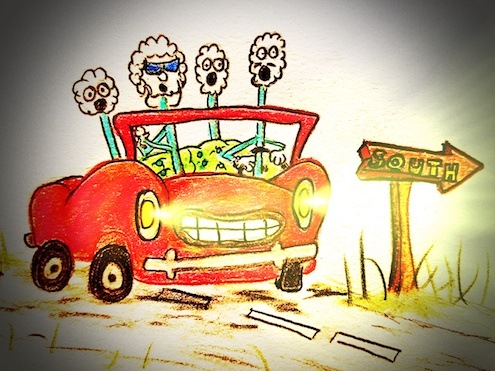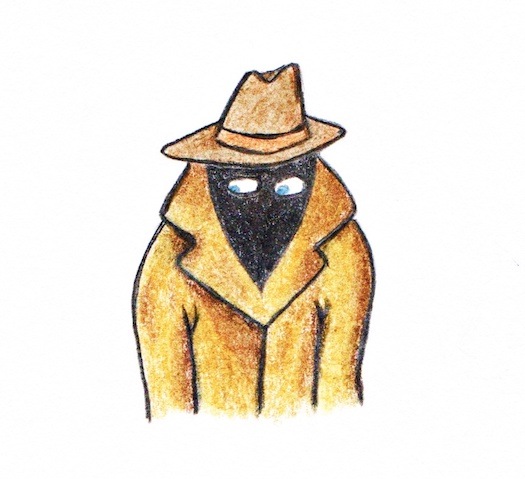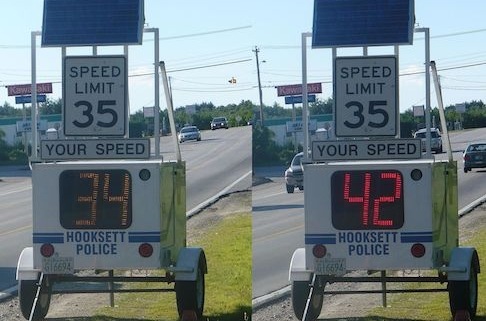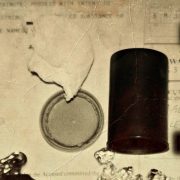I Spy with My Little Eye … Every Breath You Take, Every Move You Make
You’ve all seen them, those portable signs that wink and blink and flash the speed you’re traveling along your neighborhood streets and local freeways and highways. Those police-installed rolling devices that make us quickly hit the brakes as if somehow a tiny motorcycle cop will magically spurt forth from the butt of the mechanism to chase us down to instantly scrawl out a traffic citation for the serious crime of driving three miles over the posted limit.
They’re the rulers of our roads. The kings and queens of our thoroughfares.
And they are …
SPIES!
Yes, it’s true. Some of those seemingly harmless speed-reducers are more than meets the eye. All while pretending to help cut down on zippy commuters or elect to ignore speed laws, their true purpose is to capture our license plate numbers at a number somewhere near 2,000 per minute if pressed to do so.
Sure, we know the local police drive cars equipped with license plate readers (LPRs) and they’re used to help locate stolen cars and even the folks who’ve skipped out on paying local taxes and utility bills.
But these winky-blinky and quite intimidating undercover radar speed signs serve yet another purpose … to nab drug and human traffickers and money launderers, and, well, practically any criminal type who travels the roadways, especially on high drug and money trafficking corridors such as the southwest border area and up and down the northeast and southeast drug corridors, such as Interstate 95, where even I’ve conducted drug interdiction traffic stops.
It’s true, not only is Interstate 95 used by “Q-tips,” the nickname traffic officers sometimes assign to the white-haired folks otherwise known as “snowbirds,” the road is also frequented by crooks, robbers, murders, chiefs, and drug dealers and their mules.

White-haired retirees are sometimes referred to as Q-tips by traffic officers patrolling the main drug corridors. This is so because a grouping of them stacked together in a sedan loosely resemble a box of cotton swabs.
To help catch the bad guys (not the Q-tips), the DEA (federal Drug Enforcement Agency) has and still is purchasing a number of trailer-mounted speed display contraptions from RU2 Systems Inc., a private Mesa, Arizona company, but the twist they’ve added is that their roadside warning signs are equipped with license plate readers.
A Canadian company called Genetec supplies the actual reader, but two small machine shops have been retained by the agent to conceal the readers inside the electronic speed signs. One of those companies is located in California, the other in Virginia, and their job is to conceal the readers within the signs.
I Didn’t “Do Nuffin’, So Why the Concern?
Well, license plate readers are a form of mass surveillance that collects information on everybody who drives by and the information is stored in case they may someday, somewhere commit a crime.
Okay, no big deal. You don’t do nuffin’ illegal so no worries. However, the police/DEA are not just keeping the data to catch crooks in the acts of crookedness, they’re applying more and more algorithms to the database that allows them to learn peoples’ travel patterns, the precise location of your marijuana supplier, where you sleep at night and what time you left that location and, another example—medical facilities that treat immigrants, including those not legally in the U.S.
The devices provide enough data that could allow those secret agents to enter an address and see everyone driver who visited it and when they were there.

These massive electronic files are stored at various location, such as Vigilant Solutions of Livermore, California, a firm the US Immigration and Customs Enforcement agency uses to access LPR data as far back as five years. This is particularly useful because to law enforcement because, and here’s a new twist, some readers capture images of the occupants of the cars that pass, meaning iCE, and other law enforcement agencies, can learn if one or more of your passengers were/are wanted for crimes committed. This is accomplished by using facial recognition software that compares images from the vehicle to the recognition software database.
Officers on the streets have realtime access to these programs and they’re able to do so almost immediately using their cellphones.
When officers want to search a home or personal records such as bank account information, they need a search warrant. A warrant is not required to make use of the Roadside Spies. The data is available to cops everywhere.
All they need to do is, well, ask and they shall receive.
Every breath you take
Every move you make
Every bond you break
Every step you take
I’ll be watching you
Every single day
Every word you say
Every game you play
Every night you stay
I’ll be watching you
~ The Police





